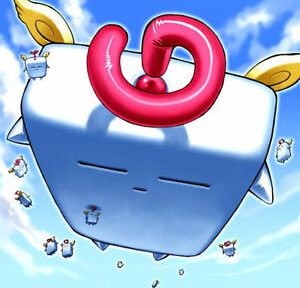
Often times when people talk about politics in comics, they are usually upset about the wave of progressivism that has become more dominant since the 2010s. Some people often say that it has always been this way, perhaps citing things like Wonder Woman, John Constantine, and the X-Men, and these are all valid examples, but I think the argument is not solid. Comics have always been “political,” but not necessarily progressive. In fact, there has been more conservative-leaning comics for a while, and it seems many people just have not noticed, but they have gone away over the years. Of course, I am a leftist, so my point here is more so to point out that they existed, but do not exist as much as of the 2010s. Frankly, to me, that is a good thing. Why?
Because all of the examples I will be sharing here with you are complete and utter garbage.
So that’s my goal here. Sure, comics may have been “political,” but these are pop fiction serials targeted at younger and developing audiences. It seems that the people moaning that they are now “political” never noticed when they conveniently were ideologically comfortable for them and the people who are comfortable with the new progressivism are overlooking the many times when comics clumsily erred into poor soapboxing.
That being said, I am not defending silly things we may see now by making this post highlighting old examples of poor conservative political commentary, and ignoring silly ones on the other side of the fence such as Angela Queen of Hel having a character randomly rant about his drunken old man conservative opinions, the uncanny cynical pages of the America Chavez series, or page long multi-paragraph spreads about the relationship of jokes with hate speech in new X-Men. Instead, I am trying to expose a double standard in what gets the attention in criticism and what does not.
So, here are some center to right-of-center bad comics that people overlooked.
10. 70s, 80s, and 90s Anti-feminism
A common theme of late 20th Century comics was anti-feminism. You would see it in both Marvel and DC Comics. Transformers, which used to be published by Marvel, had the origin of Arcee infamously be a mob of angry feminists complaining to the Autobots that they are all men and that there should be a woman among them. Their response was that them appearing as men was merely a coincidence, since they do not come from this planet. The feminists insisted, so the Autobots built Arcee, but the feminists grumbled further that she was pink and small and enforced gender roles, so the Autobots saw that they could not please everyone.

This is a pretty contrived and silly plot. You can also tell that it was shaped by its time. While these days you may see stories like this, people will generally groan or, rightfully, think you are cringe-worthy for making such a story. Trivializing feminist objections based on its loudest and incorrect defenders is not an interesting story, it is a strawman argument made into a story. Or more charitably but still unfortunately, it shows a heavy, skewed prioritization of a male perspective over a female perspective.
Nevertheless, you can also find other stories around the time where women suddenly object to being saved and call men “chauvinists” or the women are called “women’s libs” at the drop of a hat for no good reason. Captain Atom and Hercules Unbound are some examples of that.
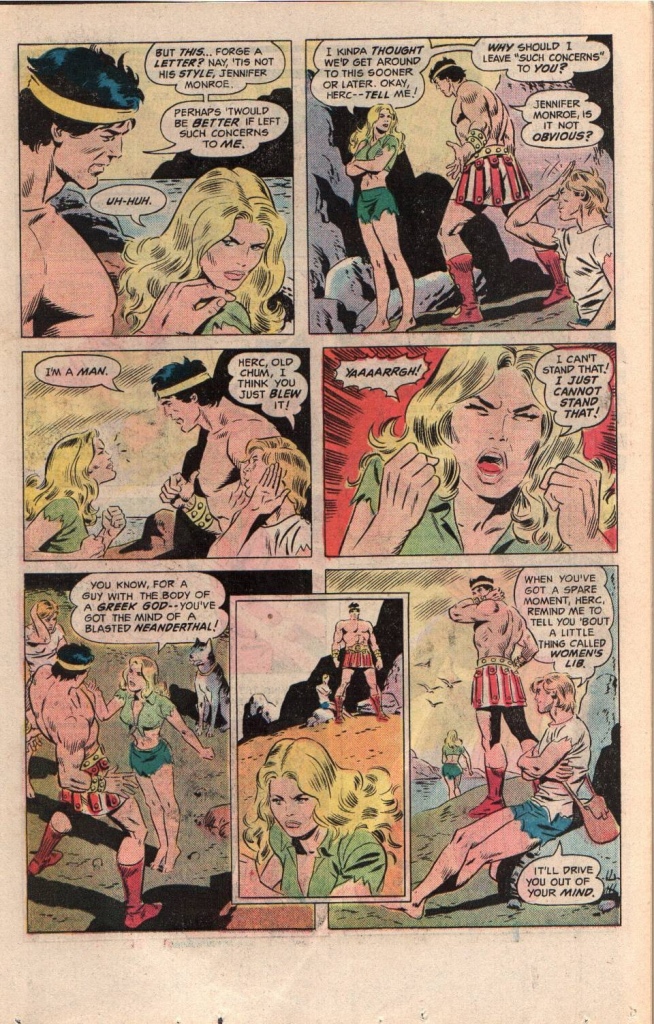
To mix it up with another Marvel example since I am sure that Transformers barely counts, here is the cover of Avengers #83 and an analysis on it, a seemingly direct response to the Women’s Liberation Movement.

There is also the infamous panel of Superman mocking a nearby crowd of “women’s libbers,” which I think even if Superman does not agree with a feminist, it is still not in character for him to act so dismissive and mocking towards a group of people.


Another possible example of it sort of happening out of the hat is Power Girl, where I am not sure if it is an example of this or an earnest character trait of hers.

One of my favorites is Fury of Firestorm. I like it because it is the backstory of a famous villain, Killer Frost. She begins to hate all men because the man she fell in love with rejected her advances. I don’t think this one is offensive, it’s just funny, and I think its sheer absurdity along with the fun campiness of the rest of the comic made it age pretty well. As a matter of fact, I miss when Firestorm was goofy and weird like this.

Whenever I read an older comic and there is some weird attitude about women in it, it often derails or dilutes the story with some contrived mischaracterization. Since it was a general phenomenon, I thought it deserved its own spot. This isn’t the end of the anti-feminism, however, as the next entry ties into this one.
9. The feminazis of Lobo


One of Lobo’s early antagonists was a group of angry feminists with Nazi memorabilia on them with generally a list of reasonable demands. They don’t even really believe anything that wrong, they just kill people and are posited as the villains.
They interrupt Lobo after he was bitten by a vampire which turned him into a werewolf somehow. Lobo started to crave flesh, so when the women hijacked the newly reopened Al’s Diner to kill Al for being a man, Lobo as a wolf started eating the feminists and stopped their feminist revolution.
So why is this so low if it is so blatant? Well, that’s just Lobo’s style. Parts of Lobo have not aged as well, but it was always meant to be a meaningless comic that acts punk to absolutely everything. I can see why someone would loathe the insincerity of Lobo, but I think giving more points to a comic that deliberately tries to be provocative is kind of cheating. Besides, Lobo is not an instructional, well-thought-out comic like the others on this list are striving towards. Lobo is the most mindless comic entertainment, and I think if you asked an artist or a writer on these issues, they probably did not think much about it but did sort of take from their times in a reactionary way. Lobo is still funny, edgy if you can take it, and it is a time capsule of wacky DC space we used to have that I wish we could have again.
8. The Bat Family and chastity

Chuck Dixon, who will come up again for sure, is an infamous writer for just being really petty about the darnedest things such that it does affect his writing and it has distracted readers. One of the more minor issues I chose for this entry: the way sexuality was handled during his reign as a major Batman universe writer.
Sure, we have seen people have hang-ups about what is acceptable to show in front of kids. What I think some forget, however, is that there are also religious hang-ups about sex before marriage. Many religions have become more unorthodox and have tolerated more new things, but the idea of sex after marriage has stayed with some, including Chuck Dixon on Nightwing and Barbara Gordon:
“When I was writing Dick Grayson and Barbara Gordon’s romance I stayed away from stating that they were in any kind of sexual relationship. You could absolutely imply it. But you could just as easily tell yourself they were saving it for marriage.”
As well, in Detective Comics #711, Dixon made it so that Bruce Wayne has stood up beautiful dates that he had. Premarital sex? Not for this guy!

The way he portrays men rejecting the advances of women was very unnatural and was distracting to readers. The way Green Arrow’s son, Connor Hawke, treated a sex positive story as perverse. Readers nowadays read this as Connor being averse to sex, and perhaps for this reason he has been made asexual. Other characters like Tim Drake who have been given similar strange treatment by Dixon have been made bisexual or gay in some shape or form, much to his chagrin, as he thought even back in the day that the removal of Don’t Ask, Don’t Tell in the armed forces was social engineering to allow further degeneracy and that other comic book creators allowing gay couples in their books at the time was encouraging alternative lifestyles which he does not want to even show to his kids. Very cool.
7. The Mandarin in general
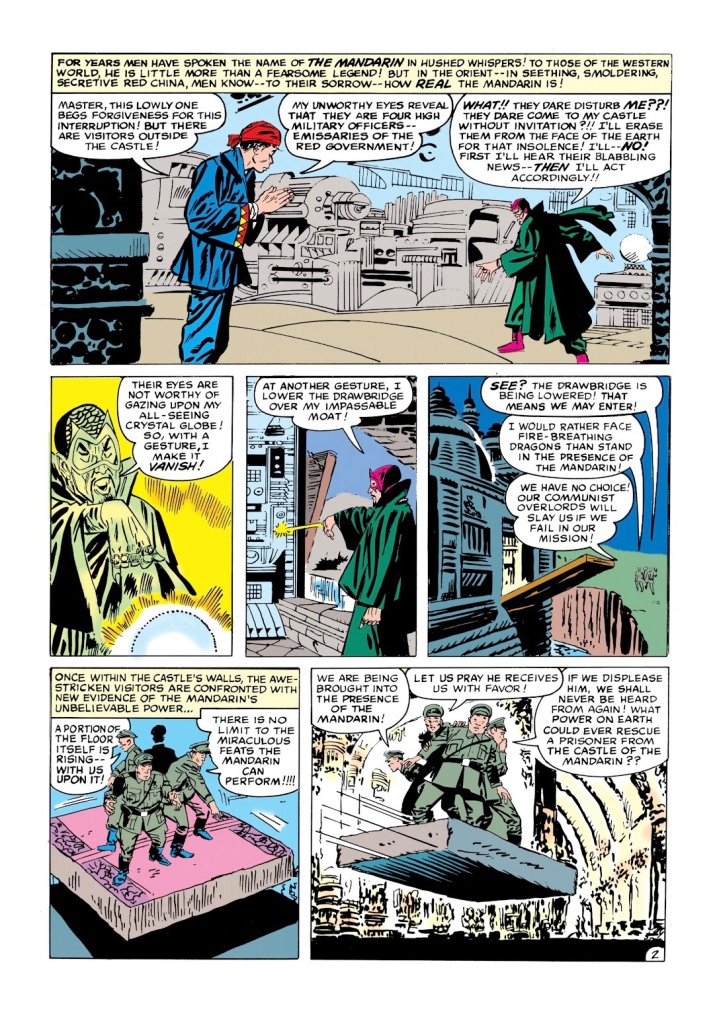
One thing that struck me as odd for the longest time was the Marvel character the Mandarin. People around me always talked about him like he was a normal character without even addressing his strange name and what it might mean.
The Mandarin is an Iron Man villain and perhaps the most mainstream portrayal of Yellow Peril that isn’t antiquated and forgotten by time. He was created by Stan Lee and Don Heck, which is a bit unusual since Lee, although now understood as more of a savvy businessman than a deeply invested writer, always seemed to be more socially liberal considering concepts such as the X-Men and Black Panther.
Tales of Suspense #50, the first appearance of the Mandarin, is filled with racial caricatures and Cold War era writing, with characters idiotically spouting lines like “Our communist overlords will slay us if we fail in our mission!” as shown above. Not a single person from China is portrayed positively in the entire issue. They are either followers or dictators. The Mandarin and other such characters would be toned down in future appearances, but I thought that it was strange that even Nazis would get more sympathetic portrayal in comics than this (see DC Comics’ Enemy Ace or Garth Ennis’ Thor: Vikings (or don’t, that comic is awful)).
The Mandarin was the villain of Iron Man 3, but like Batman Begins and its alternate take on Ra’s al Ghul, the Mandarin was revealed to be a false persona and a red herring to distract from the real villain. This choice was done to avoid being comic accurate and bring back comparisons to Yellow Peril, the phenomenon where Asians were portrayed as an existential threat to western society, often characterized by portraying Asians with deeply yellow skin, certain facial features, and villainizing them in stories.
Although I haven’t seen it, Shang-Chi and the Legend of the Ten Rings contains an original character who is also seemingly partially based on the Mandarin, once again dodging Yellow Peril comparisons. It goes to show that audiences do love these characters and concepts, but modernizing them and deliberately not making them comic accurate is frequently for the best.
6. Good morning, Vietnam!

As you might have guessed, Vietnam was an interesting time for the media. People were split on the war, and there was very low approval on US involvement in Vietnam’s affairs. A younger Noam Chomsky around this time advocated civil disobedience against the Vietnam War because it was an illegal war that would kill innocent people. Troops deployed in Vietnam may have flown a peace sign banner indicating they had no intention of fighting unless they were fired upon first. Approval of the war went from 61% to 28% over time. The effort was a hot potato that passed through presidencies. Nevertheless, for any issue you will find people on both sides of the aisle, and media supporting either viewpoint.
The topic was controversial for Marvel Comics as well. Readers generally did not want Captain America involved in Vietnam. Iron Man, as seen above, had some run-ins with foes from Asia, which would also include Vietnam.
However, American comics used to come in about four varieties. Horror, superheroes, romance, and war stories. So Marvel’s war anthology, The ‘Nam #41, crossed over with Thor, Iron Man, and Captain America during a soldier’s daydream.
The story would be alright if it weren’t for a few things. There is nothing wrong with portraying the American side of Vietnam in a favorable light so long as it isn’t defending the many indefensible crimes there. There are already famous stories out there that do so. It may be a problem, however, to portray fantasies of caricatures getting defeated by superheroes.



The story ultimately ends on an uncertain note as the men fantasizing about how American superheroes could turn the war around ponder if real heroes really do exist anymore. A pretty solid reflection on Vietnam if not for… everything else.
5. The Ultimates and the Chitauri

So, Mark Millar is a weirdo who made probably about two stories people like. I thought The Ultimates and The Ultimates 2 were an ambitious, cinematic, intriguing, but also kind of bizarre and dumb story.
As it turns out, Mark Millar based the plot of The Ultimates on conspiracy theorist David Icke. The plot of important people in power actually being reptile-like aliens was taken from his idea of the shapeshifting reptiloids called the Archons who control the world and want to subjugate humanity. The more sinister part of Icke is that although many of his fans are just gullible uneducated mouth-breathers, he also aligns with anti-semitic ideas and has had a lot of trouble distinguishing himself from anti-semitism at all. It seems that the reptilians are just a stand-in for Jewish people and his whole belief system is just recycled old hat anti-semitism. It makes sense, considering his fascination with the famous forgery meant to incriminate Jewish people as engaging in a sinister plot to control people known as The Protocols of the Elders of Zion.
So, in any case, it is funny that Mark Millar gets a kick out of The Ultimates being adapted as the MCU Avengers’ first outing. Without knowing it, a big studio blockbuster was actually a love letter to David Icke.
The Ultimates really is an incoherent, bizarre, unpleasant mess to read. I almost recommend checking it out anyway, though.
4. Hulk, breaker of worlds and enlightened centrist

Maybe one of the silliest moments out there. An entire issue in the pages of The Incredible Hulk about the Israel-Palestine conflict.
This is one that really sticks out because Hulk has basically nothing to do with foreign affairs. Hulk can often be about action, horror, and interpersonal drama, but politics that does not have to do with domestic military affairs? Hulk may be out of his league on that one.
The issue starts with a conference where controversy stirs on the maintenance of the gamma base that spawned the Hulk, and control over the Hulk being a major public concern. This is essentially filler and has little to do with the overall plot, as Bruce Banner is a stowaway in a cargo hold of a ship that is transporting goods to Tel-Aviv. Notably, people here are speaking Hebrew, but also some Arabic, with one person saying “Beard of the Prophet—!”
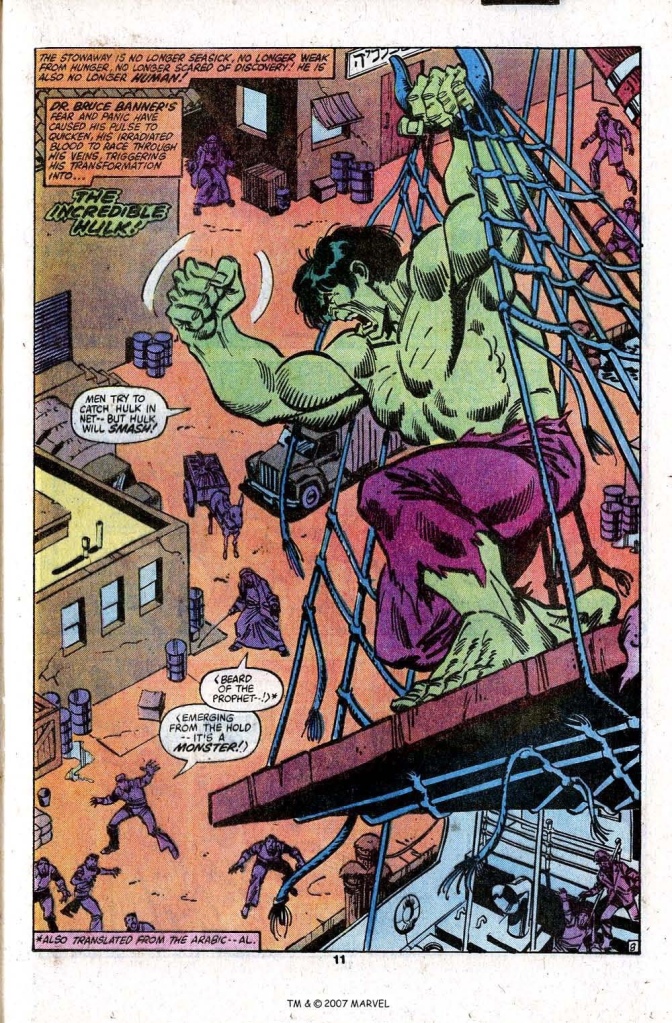
You may wonder if Muslims say that. This is actually a frequent trope in historical fiction that features Muslims, but they historically do not say that. It is just weird comic silliness placed in an otherwise serious moment.
The Israeli superhero Sabra who was introduced six issues prior makes her big debut here. Hulk is under attack by soldiers, so Sabra is temporarily knocked out before she can transform into her superhero form. Hulk does not understand why he is being attacked and expresses frustration at this but continues his rampage.
Due to fatigue, Hulk reverts to Bruce Banner. He meets a Palestinian boy named Sahad who is trying to steal a watermelon. Since Bruce is also hungry and understands the boy’s trouble, he saves Sahad from the authorities and they become friends. Sahad speaks good English because of tourists, so they can understand one another.
A Palestinian counter-force detonated a bomb while Sahad was begging for some money nearby, catching Sahad in the blast. This enrages Bruce while the terrorists go around continuing their retaliation against Israel. Hulk attacks the terrorists, but since Sabra sees Hulk in the rubble, she assumes Hulk is in league with the terrorists. Hulk and Sabra fight, which confuses Hulk. Hulk does not understand why he is engaged in conflict, and is further enraged by the fact that Sahad is likely dead. Hulk tries to save Sahad’s body and threatens his pursuers not to follow him or they will be sorry. Sabra pursued Hulk while Hulk mourns over Sahad’s now confirmed dead body.


The issue concludes with Hulk soapboxing about how someone pointlessly died in a conflict between two people who are just following what some old book says. To many people, this is their general belief on many religious conflicts. It seems so easy to just stop fighting and get over it. The problem in putting these thoughts in print, in an actual dialogue between people, is that it trivializes religious conflict. I think it would also be the best outcome for people to set aside their differences and come together, but whether that is realistically attainable is a different thing. It seems here Hulk is asserting values that are literally foreign to the people he is preaching to. And how do you convince people your values are correct?
So the whole affair becomes a lot more complicated. To put in my viewpoints, Israel is given a lot of money from the US but is not told to use it responsibly or given any terms on which they should use it. They also have not properly defined where their borders are. This is a serious problem that leads to the Palestinians losing land more and more. This combined with the fact that Zionists take a rather radical belief of the Old Testament, that everyone in Palestine should be their slave if they behave or be killed, is a serious recipe for disaster. In a sense, Hulk is right that many people support a two-state solution (or as he brilliantly put it, “sharing”) but he seems to both trivialize the religious aspect of the conflict while also bungling elements on the side of the Palestinians, like stating that the conflict is religiously motivated on the side of the Palestinians, which does not generally appear to be the case. The radical Islamic Palestinian group known as Hamas formed seven years after this issue hit the stands, many other Palestinian counter-offensive groups had secular motives. Hulk essentially recited a Keemstar tweet as his big speech.

Even if you are uncertain or disagree with what I’ve said, I think it is nonetheless agreeable that this issue, which attempts to be instructional to children on the conflict, is naive and potentially dangerous. It does not do due diligence for either side of the conflict.
3. Marvel Villains Who Have Done Worse Mourning 9/11
Following the September 11th attacks, from all sides you would see the most awkward reactions to it. Children were not untouched by this. Disney Channel ran a weird special where Disney stars would personally explain what the American flag meant to them. The randomness of this commercial bumper idea is strange, but it is demystified in light of being made in response to a post-9/11 world.
However, in The Amazing Spider-Man #36 (1999), villains weep due to the September 11th attacks. Among them include the habitual attempted tower destroyer bent on world domination Doctor Doom, the man who demanded a paradise for mutants from the world or else face dire consequences known as Magneto, Doctor Octopus, the mad scientist who tried killing people who did not recognize his scientific genius and has commanded the power to destroy an entire city before, and the crime boss who has happily built an empire on human sin, Kingpin.
Also, in X-Force #4, Juggernaut destroyed the Twin Towers. And The Living Monolith destroyed them as well in Marvel Graphic Novel #17. Um…
Yes, this was a memorial piece for 9/11, but it is clearly made with the real world in mind and comes off as very awkward and out of character with Marvel characters who either have or totally could do worse either being present or existing in the same universe as them. 9/11 was a wake-up call for many. It made them realize that the west is not loved by all of the world and that some actually harbor a great amount of animosity for its empire. As this list has proven, even the Marvel characters know about foreign relations, so all in all, this issue just seems bogus.
2. Joker, the Ambassador of Iran
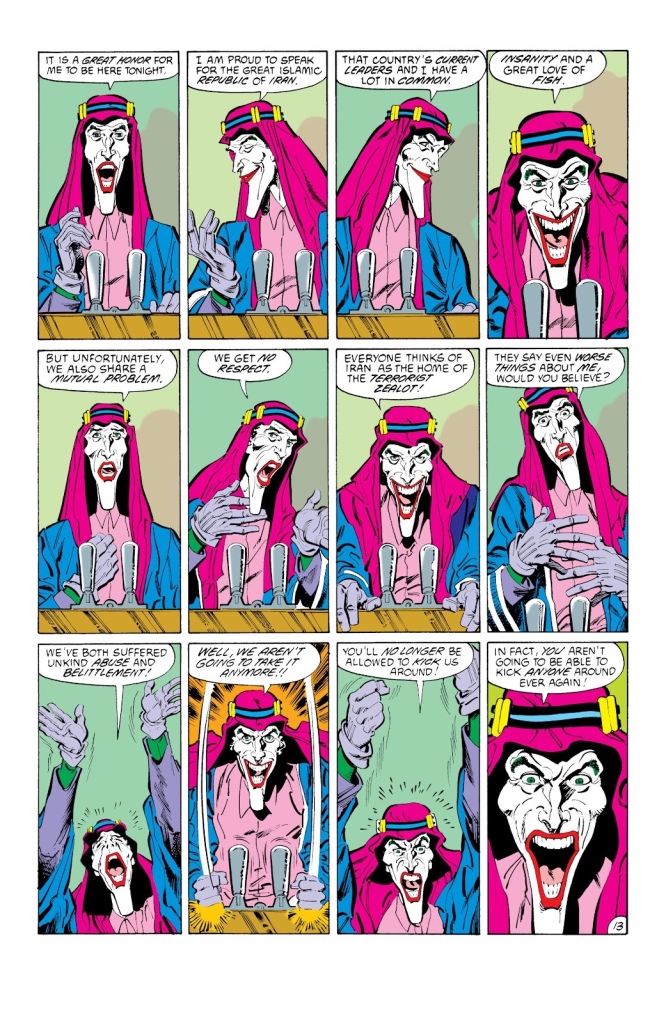
This places high because it relates to a famous mainstream Batman story.
The death of Jason Todd was a tremendous event that you probably only hear about because whether Joker kills Jason Todd or whether Jason Todd lived was decided on by the fans. In Batman #428, he was confirmed dead.
And also Joker was offered the position of the ambassador to Iran.
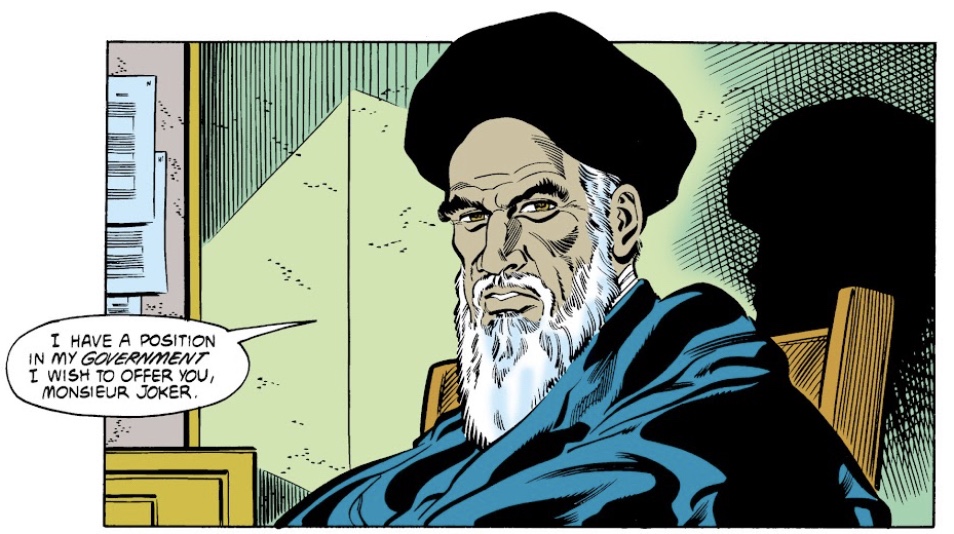
Ok, look, this story is so absurd along with many of these that sometimes it becomes so hard to tell when there is even the tiniest bit of serious intent behind it
Because Joker is a government official, he has diplomatic immunity and thus is not responsible for the crimes surrounding the death of Jason Todd.
Batman tries to confront Joker, but knows he cannot do anything. At the next United Nations conference, Joker attends and Clark Kent disguised as an attendee does as well. Joker bemoans the unfortunate reputation of himself and Iran as just being crazy terrorists, then unveils his plan to kill the UN assembly with his laughing gas. Of course, Superman is there to stop him and his plan is foiled.
What could all of this mean?
Some other ones
Here are some notable ones that I did not put on the list for one reason or another.
The Outsiders fight the Soviet Union

There are plenty of anti-Soviet comics and for good reason. I just thought this one was strange because the Outsiders do not usually deal with this sort of conflict, so it really stuck out like a sore thumb. The closest they had gotten up to that point in dealing with foreign affairs was with Geo-Force and his fictional country, where someone tried to illegally take the throne of Markovia and the Outsiders banded together for the first time to stop him. Another funny thing about this issue is that Geo-Force drops him to do his death and Batman wholeheartedly commends him for it. Very strange!
But as for the Soviet issue, it is a very strange storyline, but it isn’t as absurd as the rest and it also doesn’t convey a harmful message like many of these other comics do.
The Hemo-Goblin
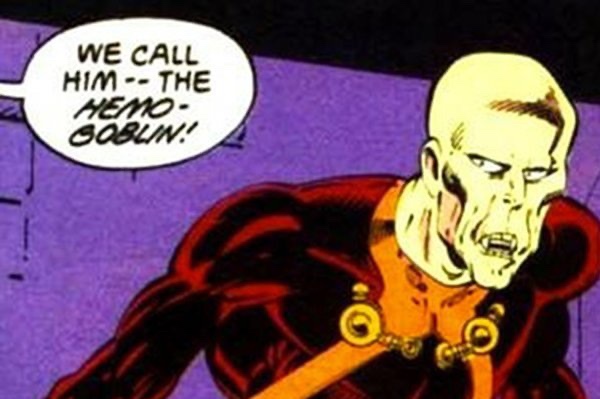
In The New Guardians, a lesser known team formed to replace the Guardians of the Universe from Green Lantern, a villain known as the Hemo-Goblin draws blood from victims and gives them HIV so that they contract AIDS. Half of the team becomes HIV positive, and one even dies. This story was meant to be a PSA for AIDS, but it ended up not doing well because it is silly. The storyline ended early.
It is worth noting that people usually only talk about this sort of thing because of Extrano, the first openly gay superhero, contracting AIDS. This is misleading. The Hemo-Goblin gave him HIV as opposed to him contracting it sexually, which is often not brought up. Extrano is stereotypical, but his portrayal is generally good rather than being a caricature like people think.
his one didn’t make the list because it is wacky and bad, but it’s intended goal is good. I’d also say that it is generally not as political as the others, at least in the sense that you cannot assign it a proper label on what kind of politics the story has.
The Peter David Supergirl “Double-Edged Sword” Story

I already talked about this one. That is probably the only reason it didn’t make the list. To summarize, a sociologist wrote a book in the DC Universe very similar to The Bell Curve by Charles Murray and Richard Herrnstein. People protested his book tour. Steel was asked to make an appearance, and tries to encourage a peaceful protest, but it rises to violence. A journalist who is the stand-in for Enlightenment liberal values of free speech and open debate is frequently attacked, and Supergirl, who is literally an angel, stops the conflict (though ironically by using force herself). The story ultimately neglects that wealth and power are being used to potentially take away the rights of black people in the story, and their ideological opposition is not arguing with reason but out of hatred. It is overall a naive and confused story. It would definitely place on the list if I didn’t already talk about it.
Holy Terror, Batman!
This is an infamous Frank Miller story that never got published but was instead reworked as its own original story. It was originally going to be a propaganda action story that feels like a Family Guy bit. It sort of bends the rules since it was made in 2011 if I chose to feature the actually published non-DC version, and I can’t feature a story that does not exist. In any case, this is a strong example of 9/11 hysteria.
One interesting thing to note, however, is that Frank Miller was the one to decide to not make it Batman anymore, not DC. He had worked on the book since 2006 and published it in 2011. He announced in 2010 that it was not Batman anymore. DC didn’t cut him off because they thought the book would hurt their brand, it was Miller himself who made the decision.
“It’s no longer a DC book. I decided partway through it that it was not a Batman story. The hero is much closer to Dirty Harry than Batman.”
1. Punisher protects Rush Limbaugh

At number one, here comes a pretty awful story with our boy Punisher.
A bunch of crazy leftists are protesting an appearance of a radio show host who is very clearly just Rush Limbaugh, well known for a plethora of controversies and generally being an insane wingnut for the neoconservative movement, and it is up to Punisher to defend him.
The issue is barely written. The characters spout dialogue no human being would ever say. If there was ever an example of an artist hard carrying the work of making comics, Punisher War Journal #37 might be it. The plot is just a bunch of dated and incoherent neoconservative ramblings and cliches strung together to make the people who already agree with it laugh and then go back to beating their wife. If there was ever an example that not appealing to diverse groups of people does not necessarily lead to better comics and that propaganda garbage can come from anyone, this would be it.
So what can we learn from all of this?
I think there is something to be said about an offender on this list, Chuck Dixon. Creator of Birds of Prey and the writer of the Punisher issue, he has been a known conservative, but not on small government, lower taxes, less regulations, liberty for the individual, promoting individualism and personal responsibility, or any of that. He is more so well-known for being socially conservative. He thinks putting gay people in comics is grooming and creepy and he thought so before it was popular to get in a panic about it. He also thinks that comics are merely a place for silly stories and should be instructional to American kids like loving their country and whatever. However, it seems that statement holds a contradiction. His idea of comics without political strife in them is just comics where his ideology goes unopposed.
And I think the same can be said for modern comic detractors as well. Chuck Dixon joined the movement Comicsgate, which specifically stands against forced diversity in comics and political agendas portrayed within them. Ever since joining, even though Dixon has previously said that his departure from DC was explicitly not due to political differences, he has changed his tune on that story.
I can understand why a push for more diversity in comics may be alienating to people who are used to a long and fairly cohesive tradition of the same familiar characters like Iron Man, Spider-Man, Batman, Superman, the Hulk, Captain Marvel, and so on. However, comics have not really changed. The stories are still about the same characters, and even when they are different like with Miles Morales, Jonathan Kent, and Miss Marvel, they still are the same general type of pulp stories. They still fight villains and overcome the same hardships they always did, they’re just a more diverse group of people.
In this sense, it does speak to a serious problem that many comic fans feel the same way as someone like Chuck Dixon and may even follow him, starting a rallying cry in agreement with him. It seems many comic fans are not challenging themselves at all. Comics are their entire world, and as a notorious force resistant to change, it seems even slight shake-ups to the status quo alienates them and makes them scared.
I can’t imagine that someone who finds that to be too challenging is much of a person who challenges their own perspective and is open to being changed or has much capacity for learning. Instead, it seems more so that they demand a constant social order to be maintained to keep their own fantasy the same as it always is.
As is often the case with movements that react to progressive changes, ComicsGate, which tried to posit itself as a sensible and reasonable reaction to the irrational and “bad” storytelling of current Marvel and DC, is an unambiguously conservative movement in disguise that tries to LARP as more of a centrist one to get more people signed on. This is why ComicsGate stories, while having artwork that is high in fidelity, lacks panel layouts and continuity that makes any sense, good characters, and original ideas. They are creatively bankrupt because all they know is superhero comics, not stories. When people try to criticize their work, ComicsGaters are often quick to lash out with great vitriol, even to their own financial backers. None of these are traits of sensible adult artists.
The comics community in general has already seen Comicsgate as the reactionary, poorly held together mob that it is, so naturally, they may find it strange when veteran writer Alan Moore claims superheroes are childish fantasies that could enable fascism. His perspective is informed by the past, which as I have shown, is filled with this sort of garbage. Comicsgate essentially is, whether he knew it or not, what he predicted.
Although comics fans in general do not need to take a lesson from that Moore quote, I think we do owe it to ourselves to challenge ourselves and broaden our own horizons. If we can fundamentally prove ComicsGaters wrong about their ideas, get them to stop worshipping the ashes of their childhood and long for it to return, then we can all move on and welcome greater things to come.
